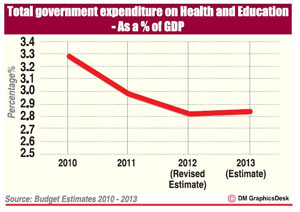Reply To:
Name - Reply Comment
 Budgetary allocations for Sri Lanka’s education sector fall short by approximately Rs.14.2 billion when compared to allocations presented in the Budget Speech by President Mahinda Rajapaksa, Verité Research, a private research firm, which provides strategic analysis for corporate and government institutions in Asia said in a report.
Budgetary allocations for Sri Lanka’s education sector fall short by approximately Rs.14.2 billion when compared to allocations presented in the Budget Speech by President Mahinda Rajapaksa, Verité Research, a private research firm, which provides strategic analysis for corporate and government institutions in Asia said in a report.
In Section 36.8 of his speech, President Rajapaksa delivered assurances that the government would continue to maintain its commitment to the free education system, subsequently proposing a 15 percent increase in expenditure, amounting to Rs.177.6 billion in 2013.
Despite such assurances, Budget 2013 ended up allocating just Rs.163.4 billion, representing only a 5.9 percent increase in spending and a reduction in the education budget in real terms.
“The claim of “not compromising on commitment to deepen the scope of free education” is almost directly contradicted. Either there has been an error in apportioning the budget, or the claim is deeply cynical,” the report asserted.
 Criticism was also leveled at the supposedly inclusive and widely publicized consultation process by which the government sought to incorporate the concerns of stakeholders, in the context of its subsequent disregard of calls for increases in education spending, particularly the demands by the Federation of University Teachers Associations (FUTA) for an allocation of 6 percent of the GDP.
Criticism was also leveled at the supposedly inclusive and widely publicized consultation process by which the government sought to incorporate the concerns of stakeholders, in the context of its subsequent disregard of calls for increases in education spending, particularly the demands by the Federation of University Teachers Associations (FUTA) for an allocation of 6 percent of the GDP.
Budget 2013’s education allocations account for approximately 1.88 percent of the GDP in 2013, implying a decline of almost 2 percent in real terms.
“It was widely publicized that Budget 2013 arose out of a process that consulted widely to incorporate the concerns of people and stakeholders in the allocations. However, the government has roundly ignored the wide public support, on the street and in the newspapers, for significant increases in the education budget,” the report stated.
Despite contradictions between government rhetoric and budgetary allocations, the report noted that the ongoing decline in education spending is not a new phenomenon and is in fact traceable to budgetary trends from 2006 onwards.
“A clear downward trend is evident in the allocations made to the education sector as a percentage of the GDP in four successive budgets from 1.81 percent in 2010 to 1.51 percent in 2013. This is driven by sharp decreases in current expenditure on education,” Verité showed.
Declines in education spending are however part of a larger policy shift in the country, according to Verite, which if continued will mean an erosion of Sri Lanka’s traditional welfare state status, as further evidenced by increasing privatization in both healthcare and education.
“Free education and healthcare are strong ideological pillars of Sri Lanka’s welfare state. However, over time, both of these have suffered erosions in quality that have required consumers to substitute the state supplied services with private complements – private clinics, laboratories and hospitals in the case of the health sector, private tuition and ‘international’ schools and universities in the case of the education sector. The total percentage of the GDP allocated to health and education in the budget, at 2.84 percent, is meager and reflects a trend of de-prioritising this historically important welfare infrastructure,” the report noted. Increased expenditure towards the Ministry of Social Services, which is tasked with the welfare of the elderly and disabled, would prima facie appear to contradict Verite’s assertion that the welfare state model is under attack. However, the report went on to highlight other social infrastructure sectors which are facing cuts or significant constraints, likely negating any benefits gained from increased spending on social services over the long term. “The increased allocation to this ministry reflects the increased priority given in this budget for direct assistance to the poor and vulnerable. It also reflects the fact that the methods of channeling such assistance is becoming increasingly diverted to flamboyant, new, personality-based political-support-building programmes that draw from various different government ministries, rather than being embedded in stable government institutions. This could negatively impact both the durability of the programmes and the productivity of the expenditure,” the report stated.
Budgetary allocations for the Ministry of Child Development and Women’s Affairs and the Ministry of Resettlement continue to show a declining trend, both as a percentage of the GDP and total government expenditure, whilst the Commission to Investigate Allegations of Bribery and Corruption saw its budget cut by a drastic 22.7 percent from 2012, down to Rs.50.4 million.
“This gradual retreat from longstanding social protection channels can increase vulnerability of those at the lower socio-economic strata. The dependency of the poor on the various new, political-support based, direct assistance schemes is likely to increase, as those schemes also grow in political significance,” Verité warned.